A true sunshine lover, Zinnias burst with vivid color and unfailing charm from late Spring through frost. These cheerful blooms come in an array of shapes and hues—perfect for adding instant brightness to borders, containers, and cutting gardens alike. Known for their resilience, zinnias thrive in full sun and reward even beginner gardeners with continuous blooms. Whether you favor bold magentas or soft pastels, few flowers bring more joy or personality to a garden than zinnias.
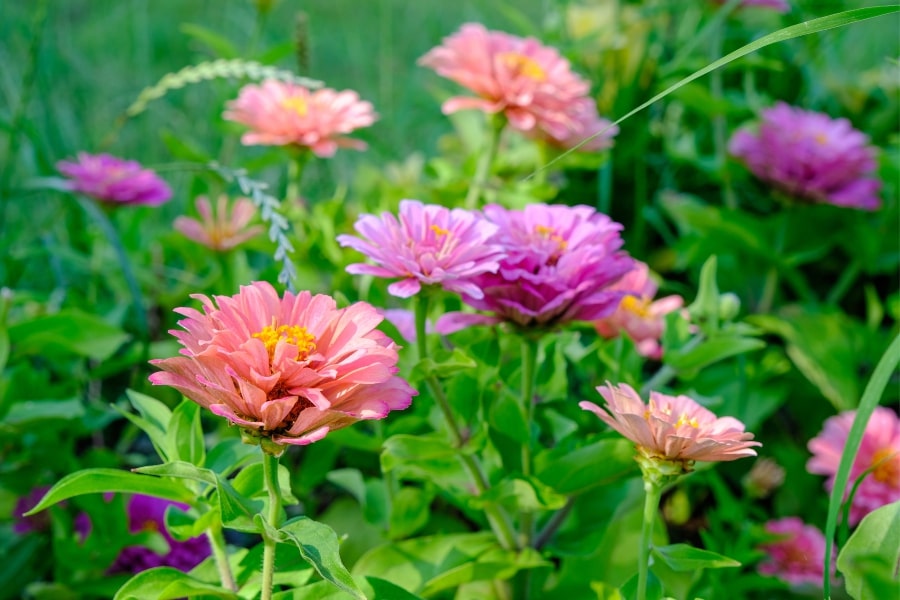
Our Selection of Zinnia
At Martin Garden Center, we grow a wide variety of Zinnias, both upright and trailing cultivars. We carry 4″ Zinnia and have them stocked in early April through May. We also carry flats of Zinnia, but theses are available sporadically; we rarely have them stocked through the end of April or early May. We do carry big zinnia pots, and they are gorgeous. These 6″ and 10″ pots usually become available in mid-May, and then we are sold out by August, sometimes earlier.
Our star offering is the Star Zinnia, which provides an upright and a trailing growth habit. None of our vendors grow it, which is why we do. We absolutely love it and so do our customers. The star zinnias are grown in a 4″ container and come in a variety of white, gold and orange colors. It is a very drought tolerant and requires no deadheading.
We also grow an upright variety, particularly the Sweet Tooth Candy Corn variety in 4″ containers. But, other than that we rely on our vendors to provide us with Zinnias, and we normally see varieties including Profusion, Zahara, Zowie, Uproar, and Swizzle among others. These are commonly grown in 3 inch containers and 4 inch containers, depending on the vendor, and these are available in the spring beginning April 1 through early summer circa May 15.
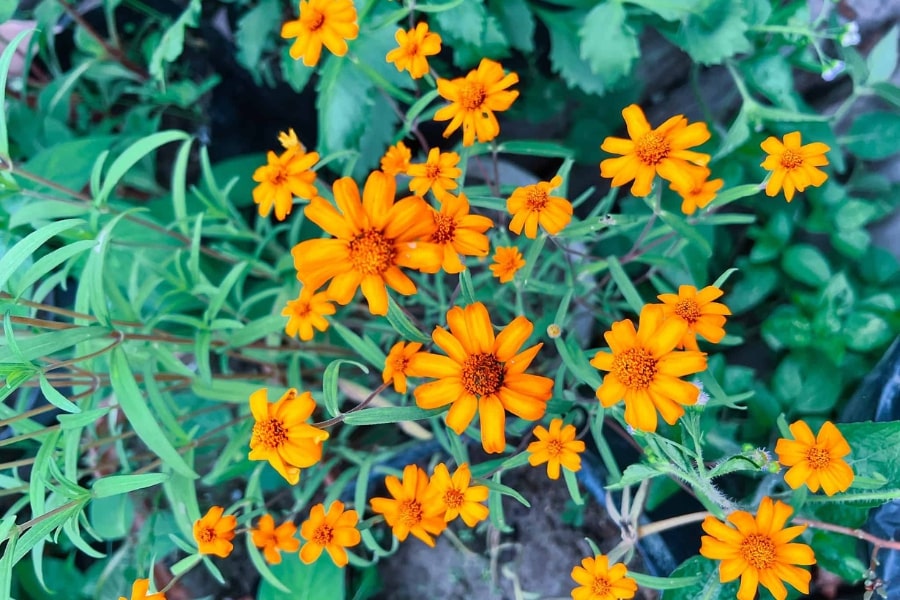
How To Grow and Care for Zinnias
Zinnias thrive in full sun, so choose a location in your garden that receives at least six hours of direct sunlight daily. They prefer well-drained soil, so make sure the soil is loose and fertile. Before planting, it is recommended to work organic matter such as compost or well-rotted manure into the soil to improve its fertility and drainage.
Watering is essential for zinnias, especially during dry periods. Keep the soil evenly moist but not waterlogged, as excessive moisture can lead to fungal diseases. Powdery mildew will plague your upright zinnia flowers. You can attempt to prevent this by watering plants at the base and avoiding wetting the foliage. But, even with these measures, it is likely that powdery mildew will erupt. You can either ignore it or attempt to prevent it from recurring by applying fungicides. Copper fungicide is an organic solution that helps prevent the recurrence of powdery mildew.
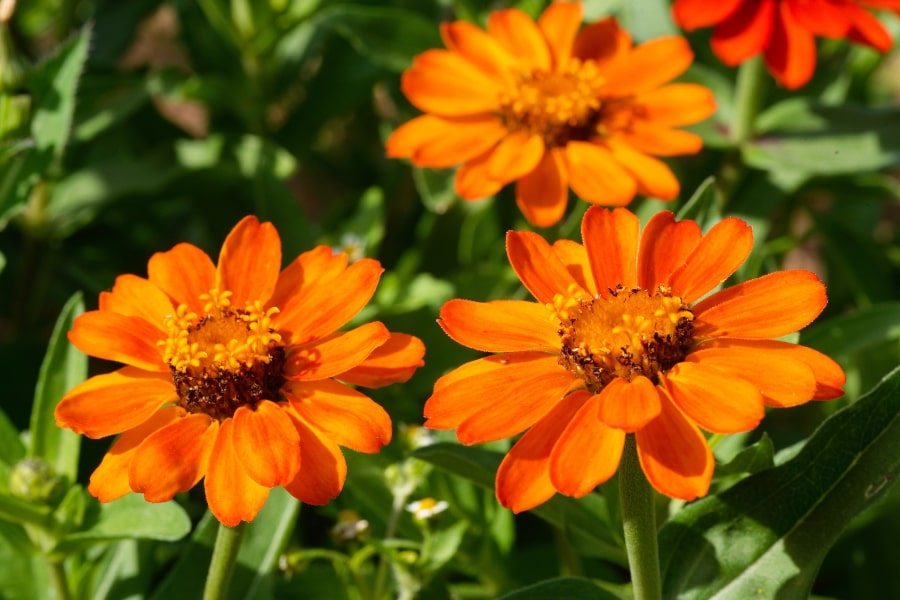
Leaves and Flowers
Zinnia flowers are beloved for their bright and showy blooms. As mentioned previously, they come in a wide range of colors. The flowers can be single or double, resembling daisies with a central disk surrounded by colorful petals. Zinnia leaves complement their stunning flowers with their attractive foliage. The leaves are lance-shaped and generally green, but some varieties may have bronze or purple hues. They are arranged alternately along the stem and have a slightly rough texture. Zinnia leaves are essential to the plant’s growth and photosynthesis, providing the necessary energy for healthy flower production.
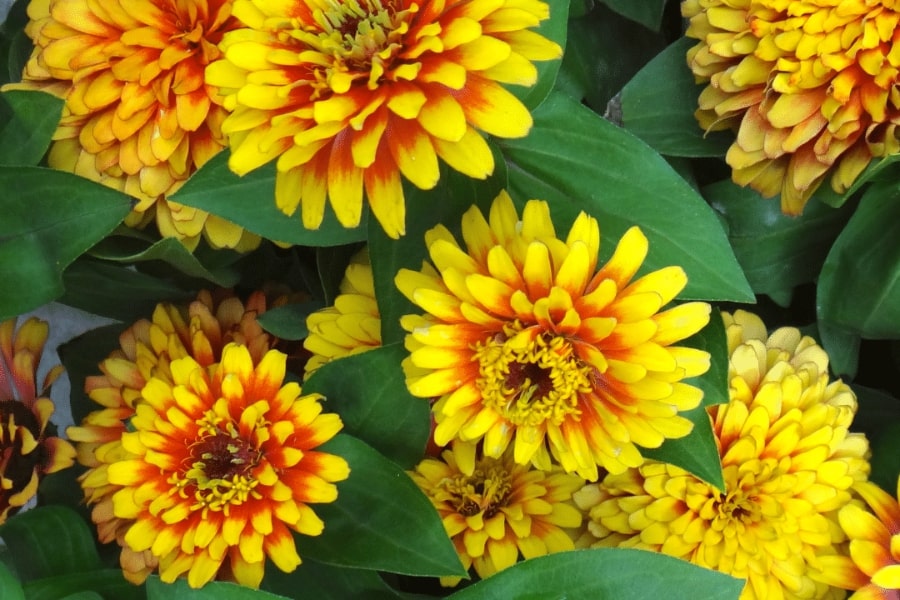
Uses in The Garden
Zinnias are also commonly used in floral arrangements due to their vibrant colors and long vase life and are a popular choice for wedding bouquets and other special events. Zinnias are also perfect for creating colorful flowerbeds; you can plant them in clusters or mix different varieties to create stunning displays of various colors. Zinnias also attract pollinators such as butterflies, bees, and hummingbirds. Zinnias are also well-suited for container gardening and border planting… their compact growth habit and abundance of flowers add structure and definition to garden spaces, enhancing the overall landscape design.
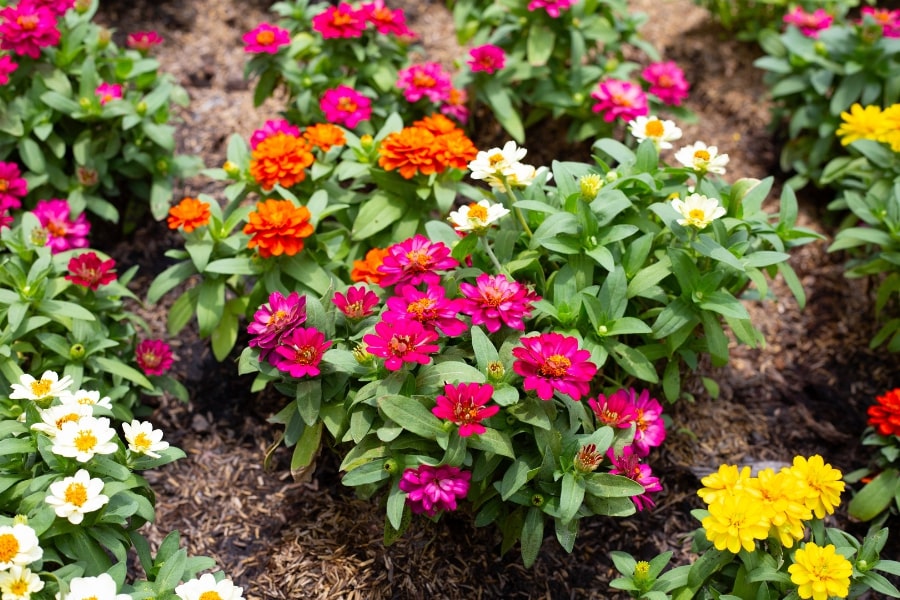
Frequently Asked Questions
Do Deer Eat Zinnias?
Zinnias are considered deer-resistant, and deer typically avoid feeding on them. The bitter taste and texture of zinnia foliage make them less attractive to deer. In times of food scarcity, deer may nibble on plants they would normally avoid, including Zinnias. If you’re concerned about deer damage in your garden, it’s a good idea to use additional deer deterrent methods such as fencing, repellents, or planting deer-resistant plants in combination with other protective measures to help keep your garden plants safe from browsing deer.
Are Zinnias Perennial or Annual?
Zinnias are grown as annuals, completing their life cycle within a single growing season. They are not considered perennials in the traditional sense.
Does Zinnia Self Seed?
Many varieties of Zinnias are known for their ability to self-seed. These seeds may germinate independently in favorable conditions, leading to new zinnia plants without intentional sowing. If you want to encourage self-seeding, consider leaving some spent flowers on the plants until they dry and develop seeds. Additionally, allow some flowers to mature and drop seeds at the end of the growing season.
How and When To Plant Zinnia Seeds
Start Zinnia seeds indoors 4 to 6 weeks before your area’s last expected frost date. This lets you have young seedlings ready for transplanting when the weather warms up. Use seed trays or small pots with well-draining seed-starting mix and plant seeds about ¼ inch deep. Keep the soil consistently moist and maintain a temperature of around 70-75°F (21-24°C) for optimal germination. Zinnia seeds can also be directly sown outdoors after the last frost date when the soil has warmed up.
Once the danger of frost has passed, transplant the seedlings into the garden or containers. Prepare the soil by removing debris and weeds. Scatter zinnia seeds over the soil surface and lightly press them into the soil. Cover with a thin layer of soil. Space the seeds between 6 to 18 inches apart according to the specific variety. Water gently to keep the soil consistently moist until the seeds germinate.
What Temperature Will Kill Zinnias?
Zinnias are warm-season annual flowers that are generally sensitive to frost and cold temperatures. Temperatures below 32°F (0°C) can damage or kill zinnias, especially if frost occurs. Even a light frost can blacken the foliage and damage the flowers. If exposed to prolonged freezing temperatures, zinnia plants are likely to die.
Zinnias thrive in temperatures between 70°F to 90°F (21°C to 32°C) and are most productive when temperatures consistently stay above 50°F (10°C). If you’re growing zinnias in a region with colder temperatures, it’s essential to plant them after the last frost date in the spring and ensure they have adequate protection if temperatures drop unexpectedly.
Are Zinnia Flowers Edible?
Zinnia flowers are technically edible but not commonly consumed as food. They are primarily grown for their ornamental value rather than for culinary purposes. It’s important to note that not all varieties of zinnias are suitable for consumption. Some varieties may have been treated with pesticides or other chemicals not intended for food crops. If you’re considering using zinnia flowers in your cooking or as a garnish, make sure that they are an edible variety and have been grown organically or without harmful chemicals.
